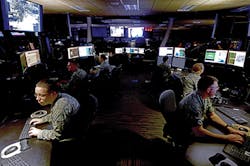Exelis turbo-charges intelligence signal-processing with supercomputer power
HANSCOM AIR FORCE BASE, Mass. - Military surveillance experts at Exelis Inc. in Herndon, Va., will add high-speed InfiniBand networking capability to a U.S. Air Force intelligence imagery-distribution and signal-processing system under terms of a $10.4 million contract modification.
Officials of the Air Force Life Cycle Management Center at Hanscom Air Force Base, Mass., are asking Exelis, a wholly-owned subsidiary of Harris Corp., to provide an InfiniBand wide-area network high-speed transport layer and data usage and dissemination capabilities to the Air Force Distributed Common Ground System (AF DCGS). The AF DCGS, also called the AN/GSQ-272 Sentinel weapon system, is the Air Force's primary system for intelligence, surveillance, and reconnaissance (ISR) planning and direction, collection, processing, exploitation, analysis, and dissemination.
The AF DCGS produces intelligence from information taken from the U-2 manned high-altitude reconnaissance aircraft, as well as from the RQ-4 Global Hawk, MQ-9 Reaper, and MQ-1 Predator unmanned aerial vehicles (UAVs), and other intelligence platforms. With computers and software connected on a network, it processes and disseminates images and other information from the manned and unmanned reconnaissance aircraft.
The system uses a global communications architecture that connects several intelligence platforms and sensors. Airmen assigned to AF DCGS produce actionable intelligence from data collected by a variety of sensors on the U-2, RQ-4 Global Hawk, MQ-1 Predator, MQ-9 Reaper, and other ISR platforms. The AF DCGS has 27 different globally networked sites, and is capable of sensor tasking and control. It can support several ISR platforms in several theaters of operation simultaneously.
Exelis tactical networking experts will provide the AF DCGS with a direct feed of information without going through a third party; increased speed for data collection and processing; and a cloud computing architecture, while supporting growing technologies, Air Force officials say.
This deal is a modification of a $13.2 million contract the Air Force awarded to Exelis last December for the Air Force Distributed Common Ground System Distributed Mission Site Reference Imagery Transition program. December's contract asked Exelis to use the InfiniBandC wide-area-network, high-speed transport layer and data storage and dissemination capabilities of the Peregrine high-performance computer (HPC) at the National Renewable Energy Laboratory (NREL) in Golden, Colo., for the AF DCGS.
The NREL's Peregrine high-performance computer architecture has 6,912 Intel Xeon E5-2670 SandyBridge processor cores; 24,192 Intel Xeon E5-2695v2 IvyBridge processor cores; and 27,648 Intel Xeon E5-2670v3 Haswell cores. This total of 58,752 Intel Xeon processor cores provide about 1.68 quadrillion floating point operations per second (PetaFLOPS) of processing power.
Peregrine also has 576 Intel Phi many-core co-processors with an aggregate performance of about 582 trillion floating point operations per second (TeraFLOPS). In total Peregrine is capable of 2.26 PetaFLOPS.
Peregrine nodes are connected on a 56-gigabit-per-second InfiniBand network. The supercomputer runs the Linux operating system and has a dedicated Lustre file system with about 2.25 petabytes of online storage and an initial capacity of 3 petabytes of mass storage.
In addition to Exelis, AF DCGS contractors include Raytheon, Lockheed-Martin, L-3 Communications, Northrop Grumman, Leidos, UTAS, Houston-Fearless, Booz Allen Hamilton, TASC, MITRE, General Dynamics, and CSRA Inc. (formerly SRA International).
On this contract modification, Exelis will do the work at separate DCGS locations and should be finished by July 2017.
FOR MORE INFORMATION visit Exelis online at www.exelisinc.com, or the Air Force Life Cycle Management Center at www.wpafb.af.mil/aflcmc.

John Keller | Editor
John Keller is editor-in-chief of Military & Aerospace Electronics magazine, which provides extensive coverage and analysis of enabling electronic and optoelectronic technologies in military, space, and commercial aviation applications. A member of the Military & Aerospace Electronics staff since the magazine's founding in 1989, Mr. Keller took over as chief editor in 1995.

